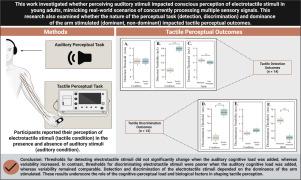Impact of an auditory cognitive load on consciously perceiving electrotactile stimuli in young adults
IF 2.3
3区 心理学
Q2 BEHAVIORAL SCIENCES
引用次数: 0
Abstract
Purpose:
Tactile perception plays a critical role in sensorimotor integration and functional task performance. Consequently, the various factors, and their interactions, that influence tactile perception are of interest when considering daily function. One such factor, cognitive-perceptual load, is of particular interest, as it reflects the mental demands placed on an individual during complex, multisensory tasks. To examine this cognitive-perceptual factor, this study evaluated how discriminating auditory stimuli impacts tactile detection and discrimination while also considering additional factors including arm dominance, sex, and age.
Methods:
Participants completed a series of electrotactile detection and discrimination tasks under single (tactile only) and dual (tactile and auditory) conditions. Auditory stimuli were introduced via a partial auditory Stroop test. Secondary factors of interest included arm dominance, sex, stimulation site, and their interactions.
Results:
Primary outcomes included electrotactile detection and discrimination thresholds and variability. Detecting electrotactile stimuli while also discriminating auditory stimuli significantly impacted the precision (p = 0.030), yet not threshold (p = 1.000), for detecting the electrotactile stimuli. In contrast, discriminating electrotactile stimuli while also discriminating auditory stimuli significantly impacted the threshold (p0.001), yet not precision (p = 1.000), in discriminating the electrotactile stimuli. Arm dominance significantly impacted the threshold at which the electrotactile stimuli could be detected (p0.001) and discriminated (p0.001). Participant sex and stimulation location (elbow, hand) had a significant interaction effect when detecting (p0.001), yet not discriminating (p = 1.000) the electrotactile stimuli.
Conclusion:
This work examined the impact of a cognitive-perceptual load on perceiving tactile stimuli, and highlighted additional important factors including arm dominance, sex, and stimulation location when assessing tactile perception in young adults. Results suggest that perceiving auditory stimuli increased the variability in detecting electrotactile stimuli. Additionally, perceiving auditory stimuli increased the threshold for discriminating electrotactile stimuli. Future work can expand these investigations to include differing populations including individuals following a neurological injury.

听觉认知负荷对年轻人有意识感知电触觉刺激的影响。
目的:触觉知觉在感觉运动整合和功能任务表现中起着关键作用。因此,在考虑日常功能时,影响触觉感知的各种因素及其相互作用是令人感兴趣的。其中一个因素,认知知觉负荷,是特别有趣的,因为它反映了在复杂的,多感官任务中对个体的精神需求。为了检验这一认知知觉因素,本研究评估了辨别性听觉刺激如何影响触觉检测和辨别,同时也考虑了其他因素,包括手臂优势、性别和年龄。方法:被试分别在单(触觉)和双(触觉和听觉)条件下完成一系列电触觉检测和识别任务。通过部分听觉Stroop测试引入听觉刺激。次要因素包括手臂优势、性别、刺激部位及其相互作用。结果:主要结果包括电触觉检测和识别阈值和变异性。在识别听觉刺激的同时检测电触觉刺激对检测电触觉刺激的精度有显著影响(p=0.030),但对阈值没有显著影响(p=1.000)。结论:本研究考察了认知知觉负荷对感知触觉刺激的影响,并强调了在评估年轻人的触觉知觉时,手臂优势、性别和刺激位置等其他重要因素。结果表明,听觉刺激增加了感知电触觉刺激的变异性。此外,感知听觉刺激增加了辨别电触觉刺激的阈值。未来的工作可以将这些研究扩展到不同的人群,包括神经损伤后的个体。
本文章由计算机程序翻译,如有差异,请以英文原文为准。
求助全文
约1分钟内获得全文
求助全文
来源期刊

Behavioural Brain Research
医学-行为科学
CiteScore
5.60
自引率
0.00%
发文量
383
审稿时长
61 days
期刊介绍:
Behavioural Brain Research is an international, interdisciplinary journal dedicated to the publication of articles in the field of behavioural neuroscience, broadly defined. Contributions from the entire range of disciplines that comprise the neurosciences, behavioural sciences or cognitive sciences are appropriate, as long as the goal is to delineate the neural mechanisms underlying behaviour. Thus, studies may range from neurophysiological, neuroanatomical, neurochemical or neuropharmacological analysis of brain-behaviour relations, including the use of molecular genetic or behavioural genetic approaches, to studies that involve the use of brain imaging techniques, to neuroethological studies. Reports of original research, of major methodological advances, or of novel conceptual approaches are all encouraged. The journal will also consider critical reviews on selected topics.
 求助内容:
求助内容: 应助结果提醒方式:
应助结果提醒方式:


